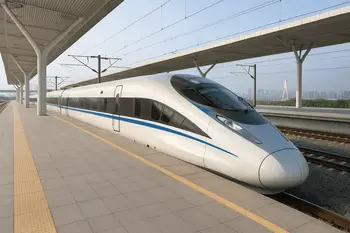
The future of travel in China’s Yangtze River Delta has arrived.
A 40-minute ride from Hangzhou to Shanghai’s Pudong International Airport will soon be possible thanks to an ambitious new high-speed rail project that promises to transform regional connectivity.
This groundbreaking development represents more than just faster travel times—it’s a leap forward in China’s transportation infrastructure that will reshape how millions of people move through one of the world’s most economically dynamic regions.
The New High-Speed Rail Line: A Game-Changer for Regional Transport
China’s top economic planner has approved a 224-kilometer high-speed rail line between the two cities, with trains running at up to 350 kilometers per hour.
This impressive speed capability places the new line among China’s fastest rail services, matching the performance of the country’s most advanced transportation corridors.
The strategic route design maximizes connectivity across the region.
The route will start from Hangzhou West, pass through Jiaxing, and end at Shanghai East.
This pathway connects major urban centers while providing crucial access to Shanghai’s primary international gateway.
Key Features of the New Rail Line
| Feature | Specification |
|---|---|
| Total Distance | 224 kilometers |
| Maximum Operating Speed | 350 km/h |
| Journey Time (Hangzhou Linping North to Pudong Airport) | 40 minutes |
| Starting Point | Hangzhou West |
| End Point | Shanghai East |
| Intermediate Stop | Jiaxing |
The most significant achievement of this project is the direct connection it creates.
Once completed, trips from Hangzhou Linping North to Pudong airport will take about 40 minutes, faster than any option today.
This dramatic reduction in travel time will make same-day business trips between these major cities not just possible, but practical.
Addressing Current Transportation Challenges
The need for this new infrastructure becomes clear when examining current capacity constraints.
The existing Shanghai-Hangzhou line, which opened in 2010, already carries more than 100 trains a day but is often overcrowded, with peak-hour tickets selling out quickly.
This overcrowding situation demonstrates the enormous demand for efficient transport between these economic powerhouses.
Current travel options between Hangzhou and Shanghai Pudong Airport involve multiple transfers and significantly longer journey times.
The Shanghai to Hangzhou High-Speed train distance is about 170 kilometers (about 106 miles), the high-speed train journey from Shanghai to Hangzhou is both swift and comfortable, typically taking around 45 minutes to 1 hour.
However, this travel time doesn’t include the additional journey from Shanghai’s main railway stations to Pudong Airport.
Current Transportation Network Performance
| Route | Current Journey Time | Daily Frequency | Main Challenge |
|---|---|---|---|
| Shanghai-Hangzhou (Existing Line) | 45-60 minutes | 100+ trains | Overcrowding |
| Hongqiao to Pudong (Airport Link) | 40 minutes | Regular service | Limited connectivity |
| Shanghai Metro Line 2 | 60+ minutes | High frequency | Multiple stops |
The introduction of the Airport Link Line has improved inter-airport connectivity.
With the recent opening of the Shanghai Suburban Railway Airport Link Line on December 27, 2024, seamless travel between Shanghai Pudong Airport and the Hongqiao Railway Hub has been significantly improved.
This development complements the planned high-speed rail line by creating better integration across Shanghai’s transportation network.
Economic Impact on the Yangtze River Delta
The new line is expected to ease congestion and expand capacity along one of China’s busiest corridors, strengthening links across the Yangtze River Delta region.
This enhancement comes at a crucial time as the Yangtze River Delta continues to solidify its position as China’s economic engine.
The region’s importance cannot be overstated. Recent developments in high-speed rail infrastructure demonstrate China’s commitment to regional integration.
Extending 260 km, the railway with a designed speed of 350 km per hour has nine stations, offering a rapid transit solution along the route threading the economic hubs of Hangzhou, Yiwu and Wenzhou in the delta area known as one of the country’s most economically vibrant regions.
Business Travel Revolution
The 40-minute connection will fundamentally change business travel patterns. International executives flying into Pudong Airport will be able to reach Hangzhou’s business district in under an hour from landing.
This convenience factor will likely attract more international investment to Hangzhou, as accessibility to major international airports often influences corporate location decisions.
For domestic business travelers, the time savings are equally significant.
A round trip that previously required a full day can now be completed in a few hours, enabling more efficient business operations and increased economic activity across the corridor.
Technical Specifications and Infrastructure Development
China’s high-speed rail technology continues to set global standards. High-speed trains on HSR Corridors can generally reach 300–350 km/h (190–220 mph).
The new Hangzhou-Shanghai line will operate at the upper end of this range, demonstrating China’s confidence in its rail technology and infrastructure capabilities.
The engineering challenges for this project are substantial but manageable given China’s extensive experience in high-speed rail construction.
The route passes through diverse geographical terrain and requires coordination with existing transportation networks while maintaining the high safety standards essential for 350 km/h operation.
Comparison with International High-Speed Rail Systems
| Country/Region | Maximum Operating Speed | Notable Lines |
|---|---|---|
| China | 350 km/h | Beijing-Shanghai, Guangzhou-Shenzhen |
| Japan | 320 km/h | Tokaido Shinkansen |
| France | 320 km/h | TGV |
| Germany | 300 km/h | ICE |
Integration with Existing Transportation Networks
The success of the new line depends heavily on its integration with existing transportation systems.
Shanghai’s airport connectivity has been significantly enhanced with recent infrastructure developments.
The Hongqiao Airport Terminal 2 to Pudong Airport Terminal 1&2 section of the line started operations on 27 December 2024.
This timing is particularly fortuitous as it means travelers will benefit from improved connections both within Shanghai and to the broader regional network.
The Airport Link Line operates at impressive speeds. Operating at speeds up to 160km/h, the line reduced inter-airport travel time from over 90 minutes to under 40 minutes.
Multi-Modal Transportation Benefits
The new high-speed rail line will create a comprehensive multi-modal transportation network that includes:
- High-speed rail connections to major regional cities
- Direct airport access for international travel
- Integration with Shanghai’s extensive metro system
- Connection to existing conventional rail services
This integration approach ensures that the benefits of the new line extend beyond just the Hangzhou-Shanghai corridor to serve the entire regional transportation network.
Tourism and Cultural Exchange Implications
Beyond business applications, the new rail line will significantly impact tourism and cultural exchange.
Hangzhou, famous for its UNESCO World Heritage site West Lake and thriving digital economy, will become much more accessible to international visitors arriving at Pudong Airport.
The reduced travel time means tourists can more easily combine Shanghai’s urban attractions with Hangzhou’s natural beauty and cultural sites in a single trip.
This accessibility could boost tourism revenue for both cities and strengthen cultural ties across the region.
Environmental Benefits of High-Speed Rail
High-speed rail offers significant environmental advantages compared to air travel and private vehicles.
For the Hangzhou-Shanghai route, passengers who previously might have chosen flights or driven will now have an attractive, environmentally friendly alternative.
The energy efficiency of modern high-speed trains, combined with China’s increasing reliance on renewable energy sources for electricity generation, makes rail travel an increasingly sustainable option for regional transportation.
Sustainability Comparison
| Transportation Mode | CO2 Emissions per Passenger | Energy Efficiency |
|---|---|---|
| High-Speed Rail | 14-29g CO2/km | High |
| Commercial Aviation | 90-120g CO2/km | Moderate |
| Private Vehicle | 120-200g CO2/km | Low |
Future Development and Expansion Plans
The Hangzhou-Shanghai line represents just one component of China’s broader high-speed rail expansion strategy.
The new 164-kilometer route connects Shanghai Hongqiao Railway Station to Huzhou in Zhejiang province, operating at speeds up to 350 km per hour and cutting travel time to 55 minutes demonstrates the ongoing commitment to regional connectivity.
Recent openings show the rapid pace of development. The first high-speed train on the new line, with a designed speed of 350 km per hour, pulled out of Shanghai Hongqiao station at 9:27 a.m. and headed for the city of Huzhou in Zhejiang by way of the city of Suzhou in Jiangsu.
Regional Network Expansion
The success of this line will likely encourage further expansion of high-speed rail networks throughout the Yangtze River Delta.
Future developments may include:
- Extension to secondary cities in Zhejiang Province
- Enhanced connections to Nanjing and other Jiangsu cities
- Integration with planned maglev lines for even faster service
- Cross-border connections to enhance international accessibility
Economic Timeline and Investment Details
While specific investment figures for the new Hangzhou-Shanghai line haven’t been disclosed, China’s track record in high-speed rail construction suggests efficient resource allocation and timely completion.
The country has consistently delivered major infrastructure projects on schedule and within reasonable cost parameters.
The economic returns from improved connectivity typically justify the substantial initial investments required for high-speed rail infrastructure.
Increased business efficiency, tourism revenue, and regional economic integration generate long-term benefits that exceed construction costs.
Conclusion: A New Era of Regional Connectivity
The approval of the new 224-kilometer high-speed rail line connecting Hangzhou to Shanghai Pudong Airport represents a watershed moment for regional transportation in China’s most economically dynamic area.
The promise of 40-minute journey times will revolutionize business travel, enhance tourism opportunities, and strengthen economic ties across the Yangtze River Delta.
This infrastructure development exemplifies China’s commitment to technological advancement and regional integration.
As construction proceeds and the line moves toward completion, millions of travelers will benefit from faster, more convenient, and more sustainable transportation options.
The project’s success will likely serve as a model for similar high-speed rail developments worldwide, demonstrating how strategic infrastructure investment can transform regional economies and improve quality of life for residents and visitors alike.
For business travelers, tourists, and residents of the Yangtze River Delta, this new rail line promises to make previously time-consuming journeys quick and convenient, opening new possibilities for economic growth, cultural exchange, and regional development.


